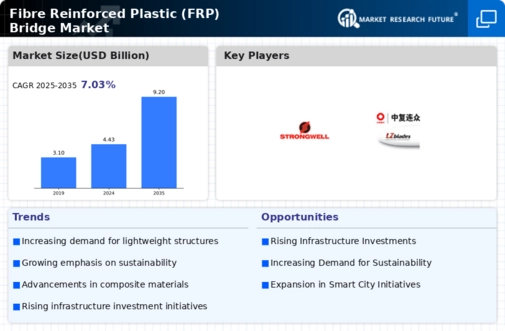Sustainability Initiatives
The increasing emphasis on sustainability within the construction sector appears to drive the Fibre Reinforced Plastic (FRP) Bridge Market. As environmental concerns gain traction, stakeholders are seeking materials that minimize ecological footprints. FRP, known for its lightweight and corrosion-resistant properties, aligns well with these sustainability goals. The market for FRP bridges is projected to grow, with estimates suggesting a compound annual growth rate of around 10% over the next few years. This growth is likely fueled by the material's ability to reduce maintenance costs and extend the lifespan of infrastructure, thereby supporting sustainable development initiatives.
Technological Advancements
Technological advancements in the manufacturing processes of Fibre Reinforced Plastic (FRP) are likely to enhance the efficiency and performance of FRP bridges. Innovations such as automated production techniques and improved resin formulations contribute to the material's strength and durability. The Fibre Reinforced Plastic (FRP) Bridge Market is witnessing a shift towards smart bridge technologies, integrating sensors and monitoring systems that provide real-time data on structural health. This integration not only improves safety but also optimizes maintenance schedules, potentially reducing costs associated with traditional bridge materials. As technology continues to evolve, the market may see increased adoption of FRP solutions.
Urban Infrastructure Development
The ongoing urbanization and the corresponding demand for robust infrastructure are likely to propel the Fibre Reinforced Plastic (FRP) Bridge Market. As cities expand, the need for efficient transportation networks becomes paramount. FRP bridges offer a viable solution due to their lightweight nature, which allows for quicker installation and reduced construction time. Recent data indicates that urban infrastructure projects are increasingly incorporating FRP materials, with a notable rise in their application in pedestrian and vehicular bridges. This trend suggests a growing recognition of the advantages that FRP brings to urban development, potentially leading to a significant market expansion.
Government Regulations and Incentives
Government regulations aimed at enhancing infrastructure resilience and sustainability may serve as a catalyst for the Fibre Reinforced Plastic (FRP) Bridge Market. Many regions are implementing stricter guidelines for construction materials, favoring those that offer durability and environmental benefits. Incentives for using innovative materials like FRP can encourage public and private sectors to invest in these solutions. The Fibre Reinforced Plastic (FRP) Bridge Market is likely to benefit from such policies, as they align with broader goals of reducing carbon emissions and improving infrastructure longevity. This regulatory environment could foster a more favorable market landscape for FRP adoption.
Cost-Effectiveness and Lifecycle Benefits
The cost-effectiveness of Fibre Reinforced Plastic (FRP) bridges, coupled with their lifecycle benefits, appears to be a significant driver for the market. While initial investment costs may be higher compared to traditional materials, the long-term savings associated with reduced maintenance and extended service life are compelling. The Fibre Reinforced Plastic (FRP) Bridge Market is witnessing a shift in perception, as stakeholders increasingly recognize the total cost of ownership rather than just upfront expenses. This perspective may lead to a broader acceptance of FRP solutions in various infrastructure projects, potentially enhancing market growth.


















Leave a Comment